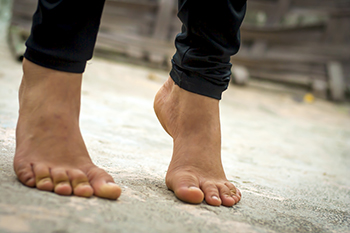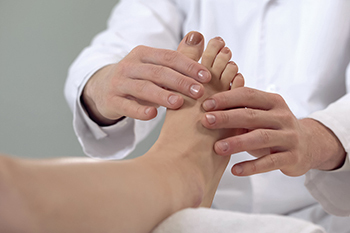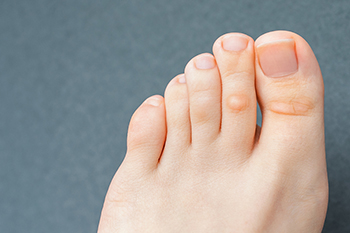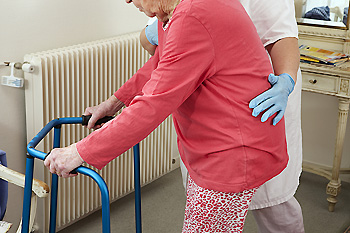September 2022
Exercises Can Help Strengthen the Feet

Taking care of the feet is something that often gets overlooked, even though we depend on them so much each day. Good foot health includes exercises that help to strengthen the feet. Starting with toe exercises, stand with your feet a comfortable distance apart. Lift the big toe on one foot while keeping the others down. Then try the opposite, leaving the big toe down and lifting the others. If you tend to pronate, rolling to the inner arch, you may have trouble lifting the big toe, and if you supinate, rolling onto the outer foot, lifting the smaller toes may be difficult. Switch feet. You can also work on strengthening the feet with heel raises. Lift the heels slowly, in order to feel the muscles working, and then lower them slowly. You may wish to hold lightly onto a chair back or wall for balance. This can be timed with breathing in and out. For more information on how to strengthen your feet through exercise, please visit a podiatrist.
Exercising your feet regularly with the proper foot wear is a great way to prevent injuries and build strength. If you have any concerns about your feet, contact one of our podiatrists from Piedmont Podiatry Associates. Our doctors can provide the care you need to keep you pain-free and on your feet.
Exercise for Your Feet
Exercise for your feet can help you gain strength, mobility and flexibility in your feet. They say that strengthening your feet can be just as rewarding as strengthening another part of the body. Your feet are very important, and we often forget about them in our daily tasks. But it is because of our feet that are we able to get going and do what we need to. For those of us fortunate enough to not have any foot problems, it is an important gesture to take care of them to ensure good health in the long run.
Some foot health exercises can include ankle pumps, tip-toeing, toe rises, lifting off the floor doing reps and sets, and flexing the toes. It is best to speak with Our doctors to determine an appropriate regimen for your needs. Everyone’s needs and bodies are different, and the activities required to maintain strength in the feet vary from individual to individual.
Once you get into a routine of doing regular exercise, you may notice a difference in your feet and how strong they may become.
If you have any questions please feel free to contact one of our offices located in Greenville, and Easley, SC . We offer the newest diagnostic and treatment technologies for all your foot and ankle needs.
Broken Pinky Toe

A broken pinky toe is a fracture of the smallest toe. This can happen from a direct impact, stubbing the toe, or dropping something heavy on it. A broken pinky toe is a common fracture and the break often happens at the toe base. Symptoms of this type of fracture include pain, possible deformity, redness, bruising, and swelling. A snapping, grinding, or popping sound can also occur when a patient breaks their pinky toe, and fever may also develop. Though the discomfort from a broken pinky toe can cause unbearable pain at the time of a break, or when touched, it might not impact the ability to walk. If the toe is broken to the point of developing an open wound, immediate medical treatment must be sought to prevent infection. It is advised that you see a podiatrist if you have broken your pinky toe, and if it is left untreated, complications and chronic problems can arise.
Broken toes may cause a lot of pain and should be treated as soon as possible. If you have any concerns about your feet, contact one of our podiatrists from Piedmont Podiatry Associates. Our doctors will treat your foot and ankle needs.
What Is a Broken Toe?
A broken toe occurs when one or more of the toe bones of the foot are broken after an injury. Injuries such as stubbing your toe or dropping a heavy object on it may cause a toe fracture.
Symptoms of a Broken Toe
- Swelling
- Pain (with/without wearing shoes)
- Stiffness
- Nail Injury
Although the injured toe should be monitored daily, it is especially important to have a podiatrist look at your toe if you have severe symptoms. Some of these symptoms include worsening or new pain that is not relieved with medication, sores, redness, or open wounds near the toe.
If you have any questions, please feel free to contact one of our offices located in Greenville, and Easley, SC . We offer the newest diagnostic and treatment technologies for all your foot care needs.
Complications of Corns

Corns are hardened spots of skin that can develop on the feet in response to pressure or friction. Specifically, corns develop on, near, and between the toes. Sometimes, corns can grow on an individual’s feet because their shoes are ill-fitting and too tight, causing the material to repeatedly rub up against the foot. This creates the kind of friction that causes corns. There are several complications associated with this particular foot affliction to be aware of. First, in severe cases of corns, the individual may experience a sensation of pain at the affected area. Having a particularly troublesome corn could also negatively impact your gait and capacity to walk or run. Severe cases of corns, if left unaddressed and untreated, might also lead to infections. Healthy tissues in and around the affected area on the foot could also be harmed or damaged by corns. If you have corns on your feet, contact a podiatrist and schedule an appointment today. This foot specialist can help you try to avoid these complications.
If you have any concerns regarding your feet and ankles, contact one of our podiatrists of Piedmont Podiatry Associates. Our doctors will treat your foot and ankle needs.
Corns: What Are They? and How Do You Get Rid of Them?
Corns can be described as areas of the skin that have thickened to the point of becoming painful or irritating. They are often layers and layers of the skin that have become dry and rough, and are normally smaller than calluses.
Ways to Prevent Corns
There are many ways to get rid of painful corns such as wearing:
- Well-fitting socks
- Comfortable shoes that are not tight around your foot
- Shoes that offer support
Treating Corns
Treatment of corns involves removing the dead skin that has built up in the specific area of the foot. Consult with Our doctors to determine the best treatment option for your case of corns.
If you have any questions please feel free to contact one of our offices located in Greenville, and Easley, SC . We offer the newest diagnostic and treatment technologies for all your foot and ankle needs.
Why Live with Pain and Numbness in Your Feet?
Exercise May Help Prevent Falling

Research has indicated that aging increases the risk of falling. There are physical reasons why many people fall, and these include the inability to retain muscle strength, which may negatively affect balance. Many people shorten their gait as the aging process occurs, and their overall strength may be affected. Additionally, reaction time may gradually decrease, and vision can rapidly become worse. People who fall may experience a fear of falling, and this can cause them to limit their daily activities. They may refrain from engaging in an exercise program, and this is not encouraged. Participating in an exercise and stretching regime can help to strengthen the body, which is beneficial in preventing falling. Effective fall prevention techniques can include having regular physical and eye examinations that can update existing medications and eyeglasses, and it is helpful to install grab bars in the toilet and shower area. Falling can affect the feet, and unnecessary foot pain may occur after a fall. If you would like more information about how to protect the feet in addition to preventing falling, please consider consulting a podiatrist.
Preventing falls among the elderly is very important. If you are older and have fallen or fear that you are prone to falling, consult with one of our podiatrists from Piedmont Podiatry Associates. Our doctors will assess your condition and provide you with quality advice and care.
Every 11 seconds, an elderly American is being treated in an emergency room for a fall related injury. Falls are the leading cause of head and hip injuries for those 65 and older. Due to decreases in strength, balance, senses, and lack of awareness, elderly persons are very susceptible to falling. Thankfully, there are a number of things older persons can do to prevent falls.
How to Prevent Falls
Some effective methods that older persons can do to prevent falls include:
- Enrolling in strength and balance exercise program to increase balance and strength
- Periodically having your sight and hearing checked
- Discuss any medications you have with a doctor to see if it increases the risk of falling
- Clearing the house of falling hazards and installing devices like grab bars and railings
- Utilizing a walker or cane
- Wearing shoes that provide good support and cushioning
- Talking to family members about falling and increasing awareness
Falling can be a traumatic and embarrassing experience for elderly persons; this can make them less willing to leave the house, and less willing to talk to someone about their fears of falling. Doing such things, however, will increase the likelihood of tripping or losing one’s balance. Knowing the causes of falling and how to prevent them is the best way to mitigate the risk of serious injury.
If you have any questions, please feel free to contact one of our offices located in Greenville, and Easley, SC . We offer the newest diagnostic and treatment technologies for all your foot care needs.





